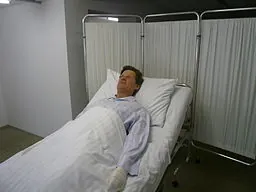Colon Injuries
While almost everyone relies on cars to travel to work, school, or run errands, car accidents are a risk every time someone gets behind the wheel or in the passenger seat. Auto accidents can range in severity from small fender benders to multi-car pileups, but even the most minor of car accidents can cause serious injuries. One of the traumatic injuries that people can sustain in a car accident is a colon injury. These injuries can occur either from blunt force trauma or due to penetrating injuries. Regardless of the type of injury, colon injuries should always be examined by a medical professional.
How are Colon Injuries Sustained in Car Accidents?
The colon is a large organ that traverses the entire length and width of the abdomen. In fact, when stretched out from end to end the entire human colon averages about five to six feet in length. This presents a large target for injury in car accidents. When cars collide, people’s abdomens can strike the front of the car or side of the car. Cars can also be compressed in a serious accident. Glass could shatter and, along with other debris, can cause significant damage to the abdominal area and colon.
What are the Symptoms of Colon Injuries?
The symptoms of colon injuries can vary widely in type and timing depending on the injury itself. Severe injuries will almost always present the following signs and symptoms:
- Diffuse abdominal pain
- Tenderness to palpation
- Increased pain on movement
- Signs of dehydration
- Bleeding
- Blood in the stool
When it comes to colon injuries sustained in car accidents, there are even more signs and symptoms that people should look for:
- Bruising around the lap portion of the seat belt
- Bruising on the flanks from peritoneal bleeding
- Swollen abdomen from leaking fluid
These are all signs pointing towards colon trauma that demands immediate attention from a trained medical personnel.
How are Colon Injuries Diagnosed?
Similar to the diagnosis of any injury, the physician will first perform a detailed physical examination. They will ask the patient about many of the symptoms described above and press on the abdomen looking for signs of a penetrating injury that might be leaking blood or fluid into the abdominal cavity. If there is concern of an injury, the physician might perform one or more of the following tests for more information:
Ultrasound: This is a quick scan that uses sound waves to look for signs of fluid in the abdomen. If there is fluid in the abdomen, the patient will proceed directly to surgery.
X-Ray: This is performed to look for signs of free gas in the abdomen. Gas leaks from the colon into the abdomen in the event of a penetrating injury.
CT scan: If the ultrasound is negative, the physician may order a CT scan to be certain that no fluid is leaking from the colon into the abdomen. If fluid is leaking, the patient will head to surgery.
How are Colon Injuries Repaired?
Depending on the degree of injury, the patient may or may not require surgery to repair the injury. If a penetrating injury has been sustained, the patient will need surgery to stop the leaking of blood or fluid into the abdomen. If there isn’t any fluid in the abdomen, the patient may simply require time and medical management to heal. Ultimately, every treatment plan is handled on a case by case basis between the patient and the physician. After surgery, it may take some time for the patient to start eating again. Every patient should use caution when eating or using the bathroom to prevent aggravating a current or prior injury.
Related Articles by Ed Smith:
- Rehabilitation after traumatic injuries
- Adominal Trauma
- Personal Injury Checklist
- Legal Resources after accident
Sacramento Traumatic Injury Attorneys
I’m Ed Smith, a Sacramento personal injury lawyer and I have handled numerous cases involving traumatic colon injuries. Please call me at (916) 921-6400 or (800) 404-5400 for free, friendly advice.
Extensively reviewed by my clients on Yelp, Google and Avvo.
:dr
Image Attribution: Wikimedia commons

